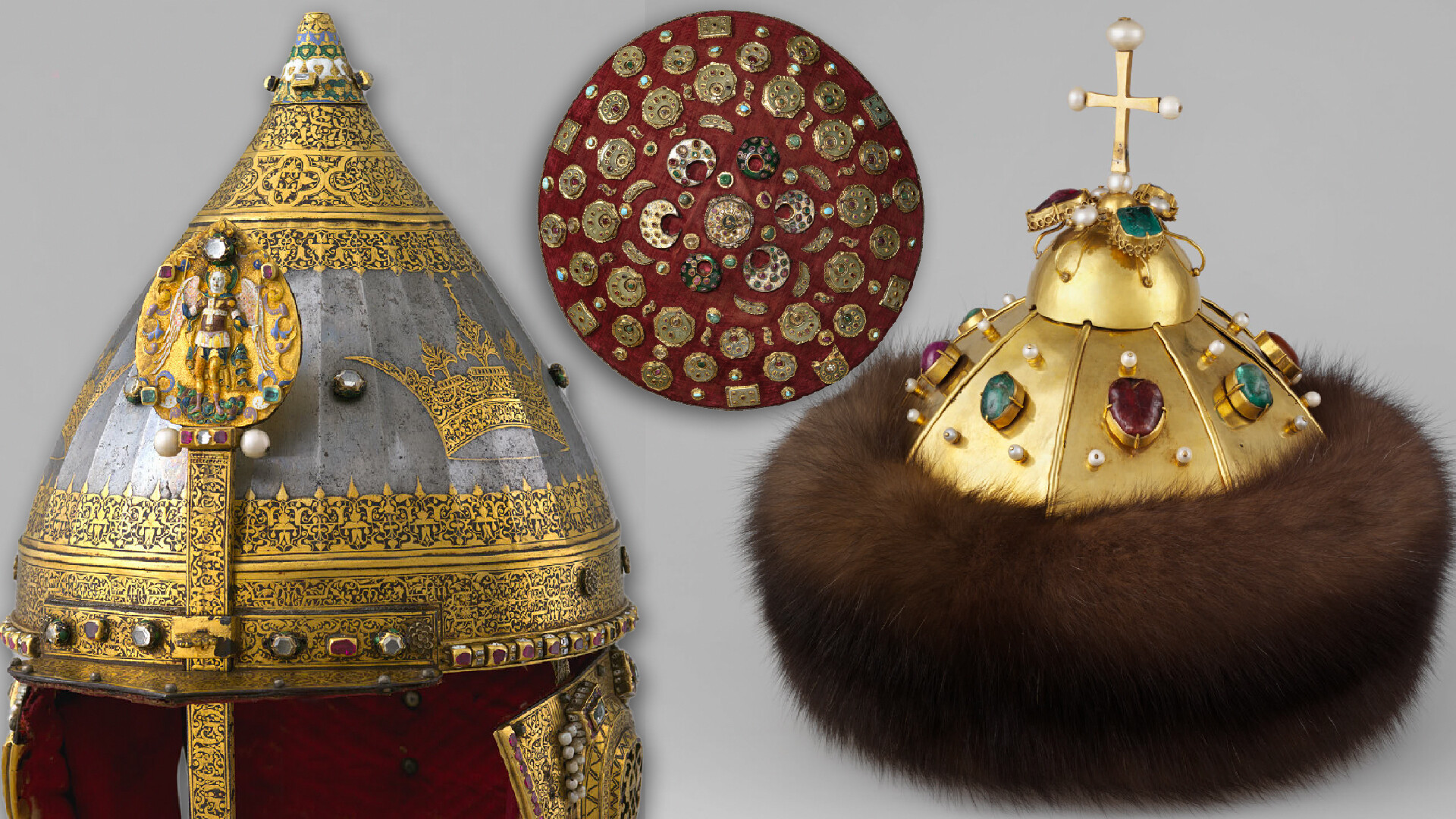
In the early 19th century, Russia was embraced by European ideas of romanticism. And the war with Napoleon in 1812 gave an incredible rise in patriotism. The Russian noble society began to look back on its history, to search for heroic moments in it, to recall legends and inevitably to compose new ones.
Court historiographer Nikolai Karamzin wrote the multi-volume ‘History of the Russian State’, which, according to Alexander Pushkin, all the high society ladies rushed to read. The history of their own country was almost unknown until then. “Old Russia seemed to be discovered by Karamzin the same as America by Columbus,” Pushkin wrote.
Historical novels were very popular, in particular, Mikhail Zagoskin’s ‘Yuri Miloslavsky or Russians in 1612’ (1829), which was about Russia freed from Polish invaders, thanks to the people’s militia.
In the time of Nicholas I (the second quarter of the 19th century), Russia became fascinated with the Middle Ages and chivalry. And historians began to look for artifacts related to the heroes of national history and their feats of arms.
Back in the early 19th century, the Armory Chamber of the Moscow Kremlin became an open museum. But, historical relics in it sometimes received fictitious attributions. Suddenly, the most famous exhibits – armor, helmets, crowns – began to be attributed to the great heroes of the past. Below are the most incredible of the many legends that have long accompanied these important historical items.
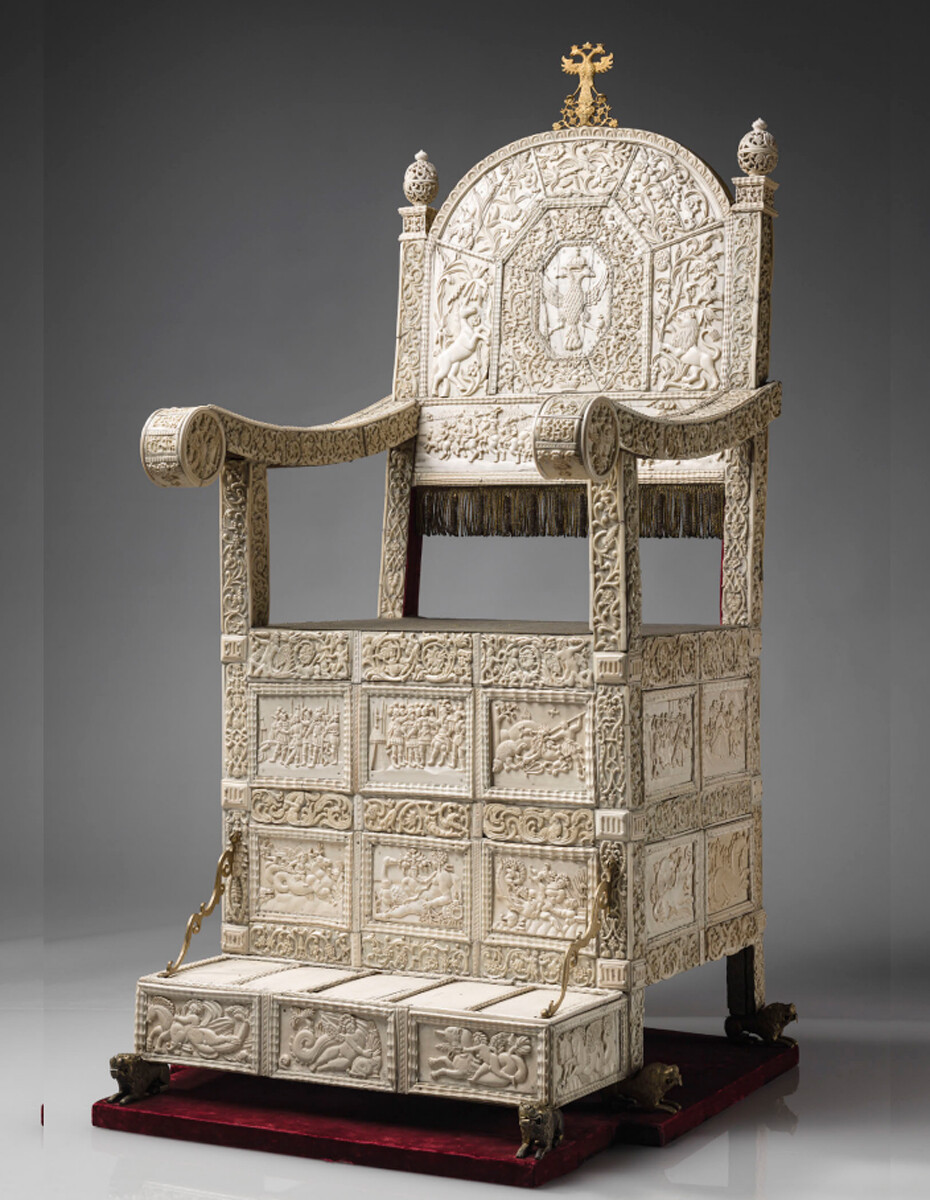
In the 19th century, it was believed that this ivory "chair" was a gift to Grand Duke Ivan III (1440-1505) from the Byzantine royal family on the occasion of his marriage to Byzantine princess Sophia Paleologos.
This legend about the throne was first described in 1807 by archaeographer Alexei Malinovsky. Without referring to any sources, the attribution was repeated many times by other historians. The legend of the Byzantine origin of the artifact was refuted by the staff of the Armory Chamber in 1884, but it continued to be attributed to Ivan III.
However, in Soviet times, a new legend emerged. In 1964, the first Soviet guide to the Armory Chamber was written, stating that the throne dated back to the 16th century and “belonged to Ivan IV the Terrible”. Perhaps, the reason for this was a late 19th century sculpture depicting Ivan the Terrible on this throne.
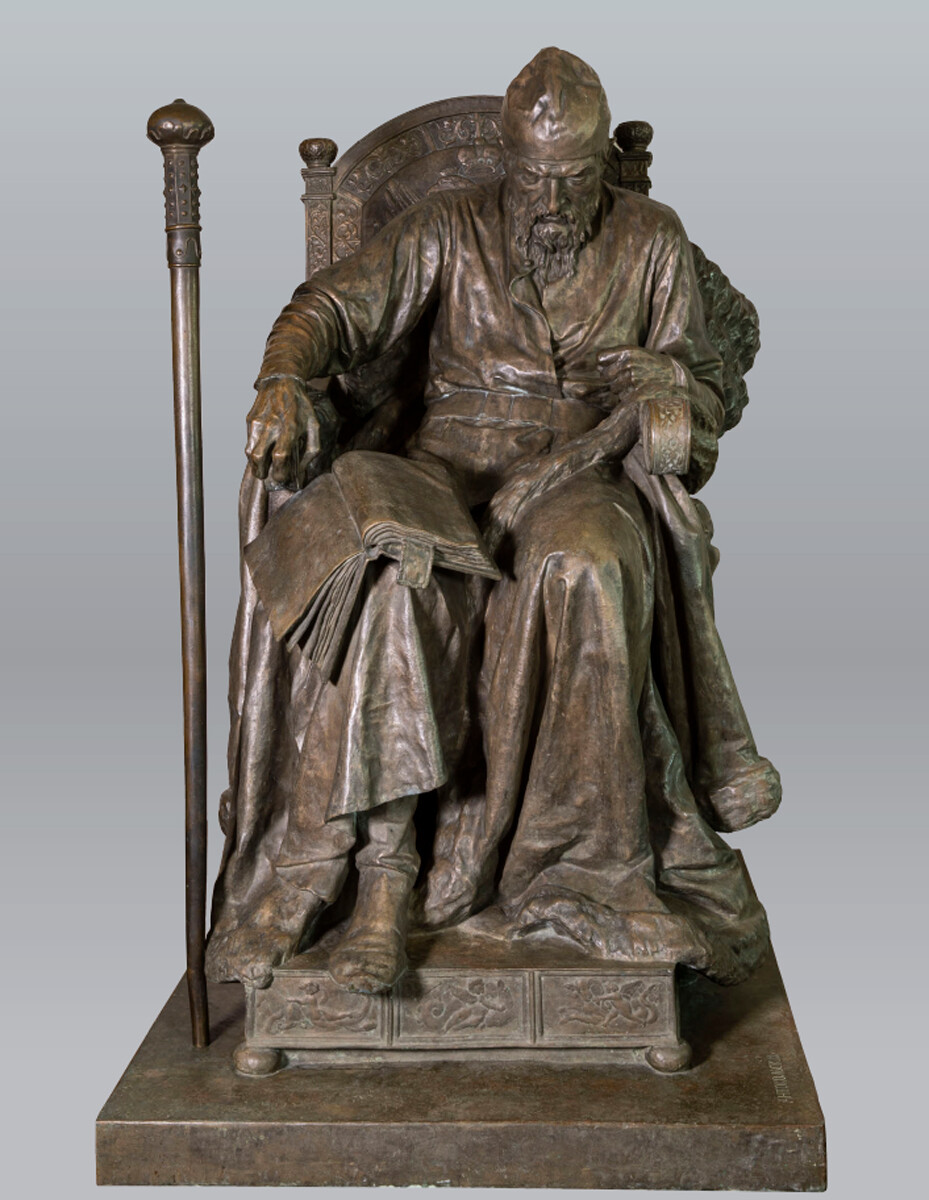
The modern attribution of the throne was proposed in the 1990s. Having studied the documents of the 17th-18th centuries and analyzed the decor, experts of the Armory Chamber suggested that most likely the throne was made by the Moscow masters, possibly with the participation of Western European masters. And that it dates back to the times of Tsar Alexei Mikhailovich (1626-1676). At the same time, the double-headed eagle and other individual plates were already installed in the 19th century.
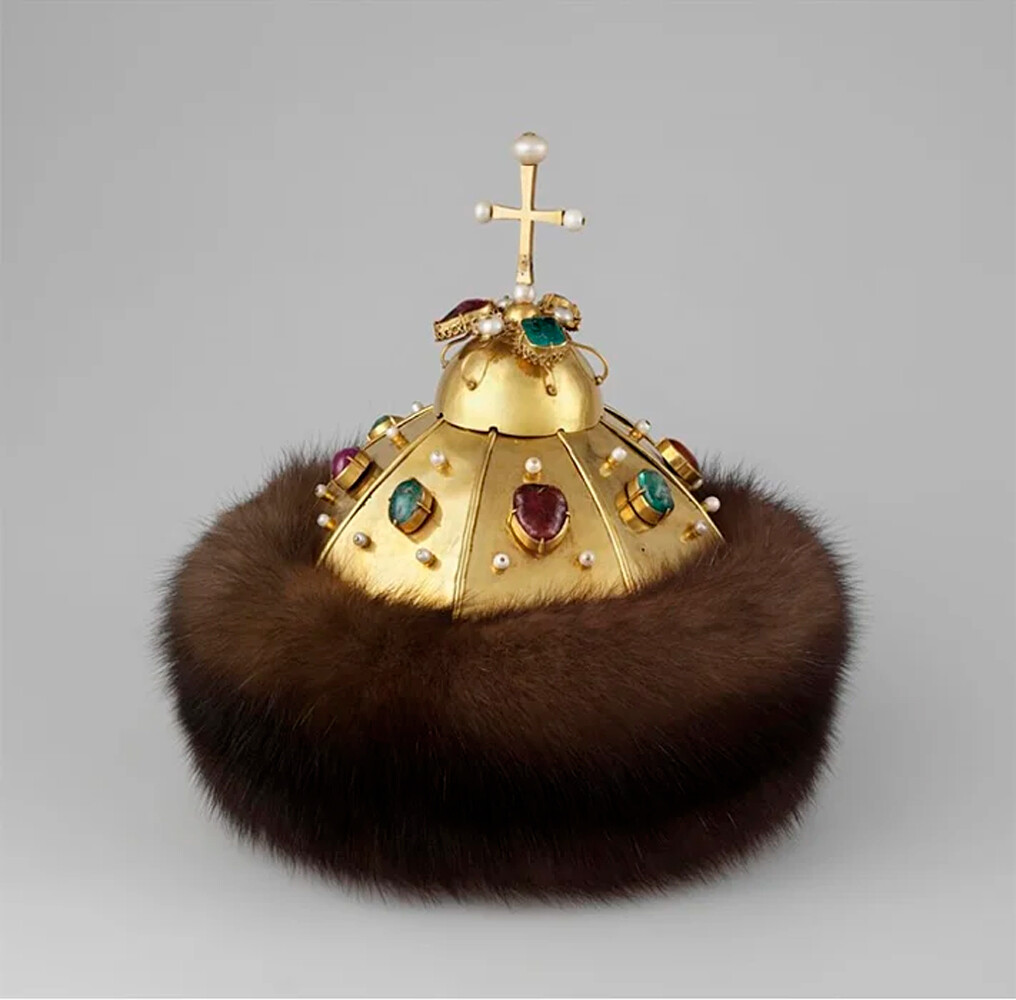
There is a famous Monomakh’s Cap that is considered one of the main regalia of Tsarist Russia. According to legend, Byzantine Emperor Constantine IX Monomakh sent it and many other royal regalia and gifts to Russian Prince Vladimir Monomakh (whose mother came from a Byzantine family). Many legends were associated with these gifts. Later, historians refuted this version and found out that Constantine had died when Vladimir was only two years old. The origin of the cap, meanwhile, remains a mystery. Read more about the Monomakh Cap here.
The one pictured above is another cap, of the “second set”. This royal crown was created in 1682, due to unique circumstances: After the death of Tsar Alexei Mikhailovich, two tsars – Ivan Alexeevich and Peter Alexeevich (the future Peter the Great) – ascended the throne at once (Read more about this story here). So, this second hat was used for Peter’s coronation.
In 1783, Catherine the Great invaded Crimea and created the Tauride region (referring to the Greek title of Crimea), adding the words: “Tsarina of the Tauric Chersonese” to her title. This was a very important step, because, according to legend, it was in the Crimean place of Chersonesos that Russian Prince Vladimir was baptized into Christianity by the Byzantine bishop.
The Cap of the Second Set was used in the funeral ceremony of Catherine the Great, calling it the ‘Crown of Taurus’. In the early 19th century, the same Alexei Malinovsky created a legend that the crown belonged to the 10th century Princess Olga herself! She was the first Russian ruler who adopted Christianity and was baptized in Constantinople (Read more about Olga here). This means that this hat would have been as much as 200 years older than the original one! Quite a fantastic version that was repeated more than once.
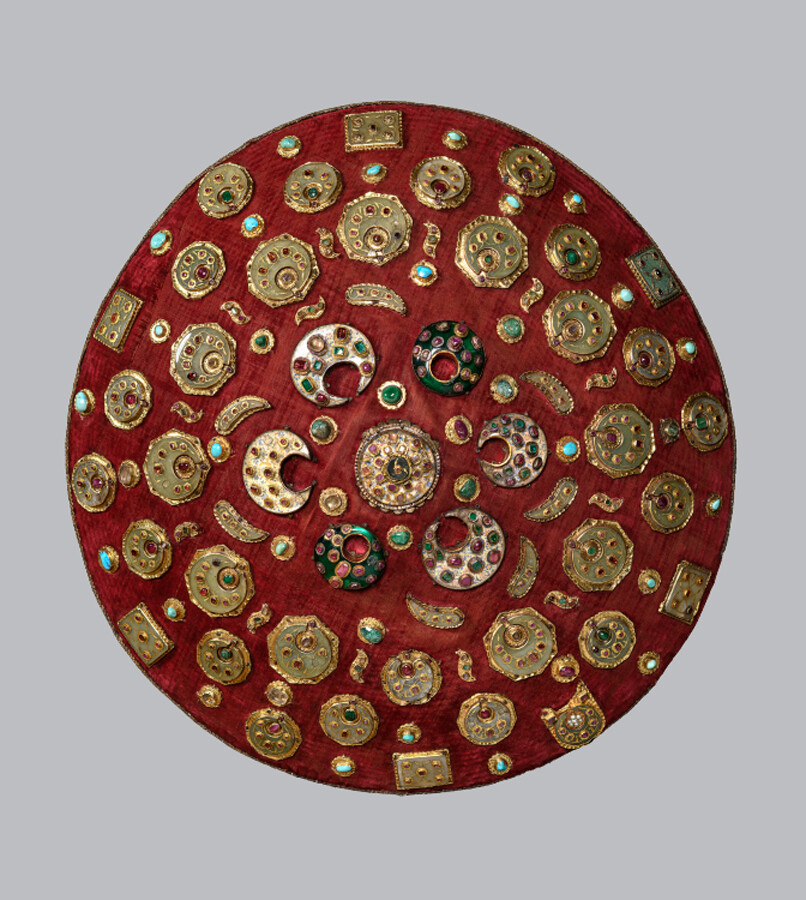
In 1807, in his ‘Historical Description’ of the Moscow Kremlin’s Armory Chamber, Alexei Malinovsky (yes, him again!) claimed that this “state shield” had been known since the time of Prince Mstislav the Great, son of Vladimir Monomakh (that is, since the early 12th century). By the way, many artifacts – helmets, armor, sabers – were attributed to this prince.
According to Malinovsky, this shield with precious stones, metals and lined with velvet, was used as a prop in weddings and coronation ceremonies. However, he didn’t provide any source or evidence of this (because none has ever been found). Already later, in the mid-19th century, the glorified shield began to be used in major ceremonies in earnest; for example, in the funerals of emperors Nicholas I, Alexander II and Alexander III.
In the late 19th century, the truth was discovered and the shield appeared to have been made in the 17th century and first mentioned in the royal inventory in 1702.
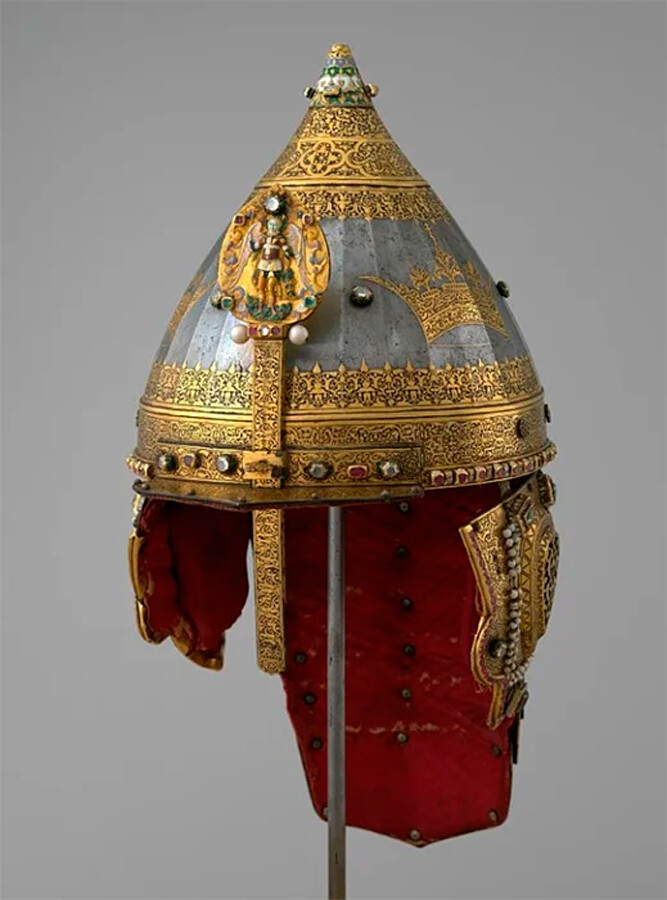
This helmet (a.k.a. ‘Jericho Cap’) was made by Moscow Kremlin armorer Nikita Davydov in the early 17th century for Tsar Mikhail Fedorovich, the first of the Romanovs. The top of the nasal arrow is crowned with the image of Archangel Michael holding a cross and a sword in his hands.
Except that, in the 19th century, this helmet suddenly began to be attributed to… Prince Alexander Nevsky! Despite the fact that the legend was justified only by some oral legends, patriotic society liked the idea and his image was even included on the Great State Emblem of the Russian Empire. Later, it also was pictured on the Soviet Order of Alexander Nevsky.
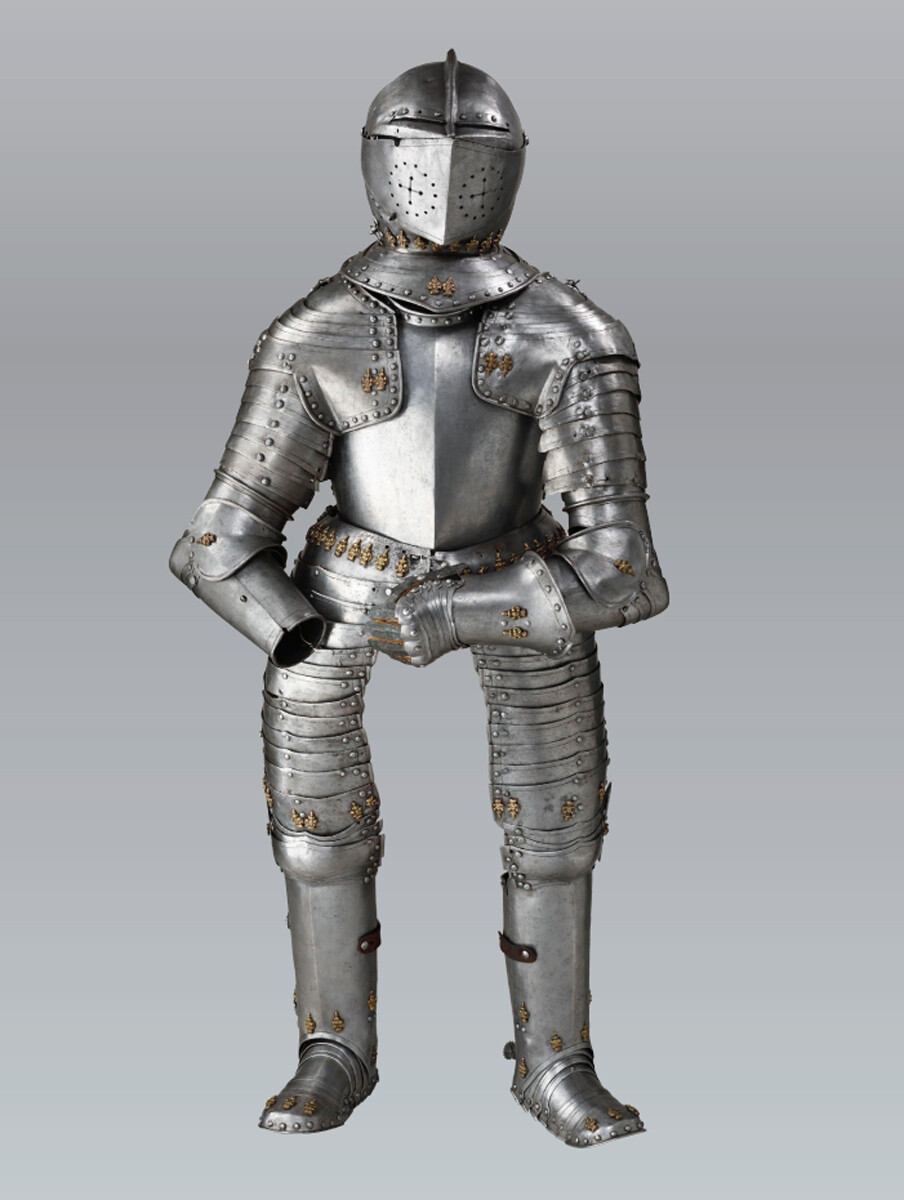
Experts put this armor 145 cm in height and 45 cm in shoulders on a par with Western European cavalry armor of the 17th century. The exact data on its origin is not known, but it may have been made in Moscow for one of Tsar Alexei Mikhailovich’s sons in the 17th century. There is also a possibility that it was also made for Alexei Mikhailovich himself when he was a teenager. At least a certain order for the 15-year-old tsarevich was indeed received by one of the Moscow court masters.
But, in the 19th century, for some reason, authors of the Armory guides attributed the armor to Dmitry Donskoy, a prince who lived in the 14th century. The legend, however, didn't catch on. Academician Alexei Olenin was the first to draw attention to the dubious attribution and considered it a figment of the authors’ “ardent imagination”.
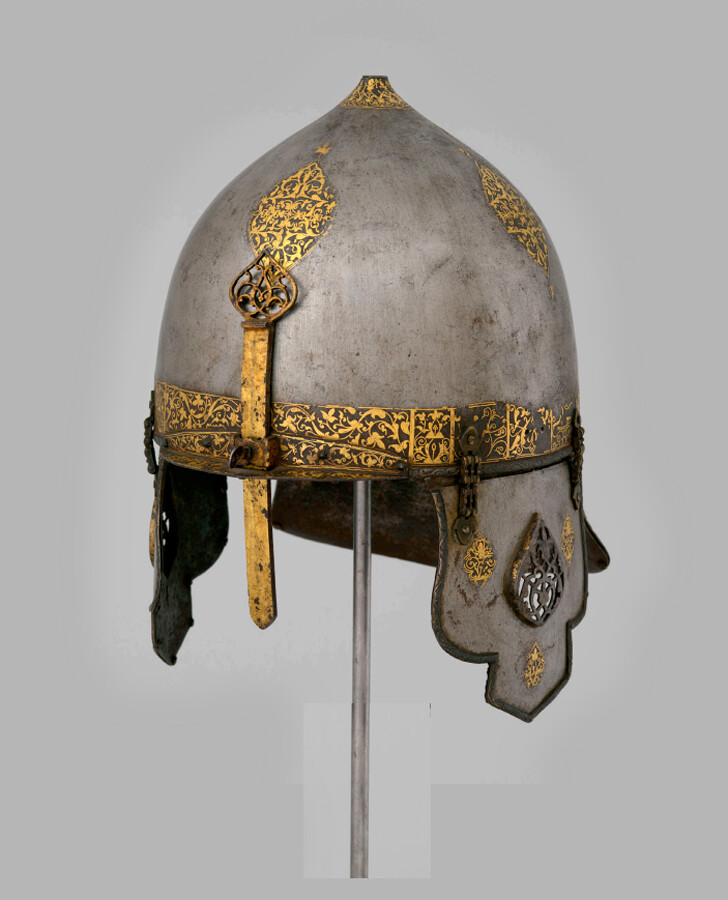
In 1809, Count Alexei Musin-Pushkin, a famous collector of historical artifacts, handed over this steel helmet to the Moscow Kremlin's Armory Chamber. He claimed that he had found the helmet near his country house on the Sit River, where the battle between Prince Yuri Vsevolodovich and the Tatar-Mongols occurred in the year 1238. The prince was defeated and died in the battle. So, Musin-Pushkin assumed that the helmet belonged to Prince Yuri himself.
In the late 19th century, the helmet was studied and experts decided that it was actually made in the Yarkand Khanate of Central Asia in the 16th-17th century.

This ivory mace with a crystal top was attributed by historian Malinovsky to Marina Mnishek, a Polish noblewoman, and, most importantly, wife of the impostors, False Dmitry I and False Dmitry II. She was an important figure of Russia's Time of Troubles in the early 17th century. According to the legend, the mace was sent to Mnishek by Shah Abbas. Probably, the conclusion he made only on the basis of the elegance of the artifact, but the legend was in circulation until the 1990s.
Modern historians believe that the mace was made in Russia. Sticks and other objects made of bone were not rare for the Russian court. Moreover, such things are in the inventories of the property of the Golitsyn noble family . Most likely, in the 1680s, the mace was made for the daughters of Tsar Alexei Mikhailovich. For example, for Natalia Alekseevna, who participated in the children's war games of her brother, Tsarevich Peter (the future Peter the Great).
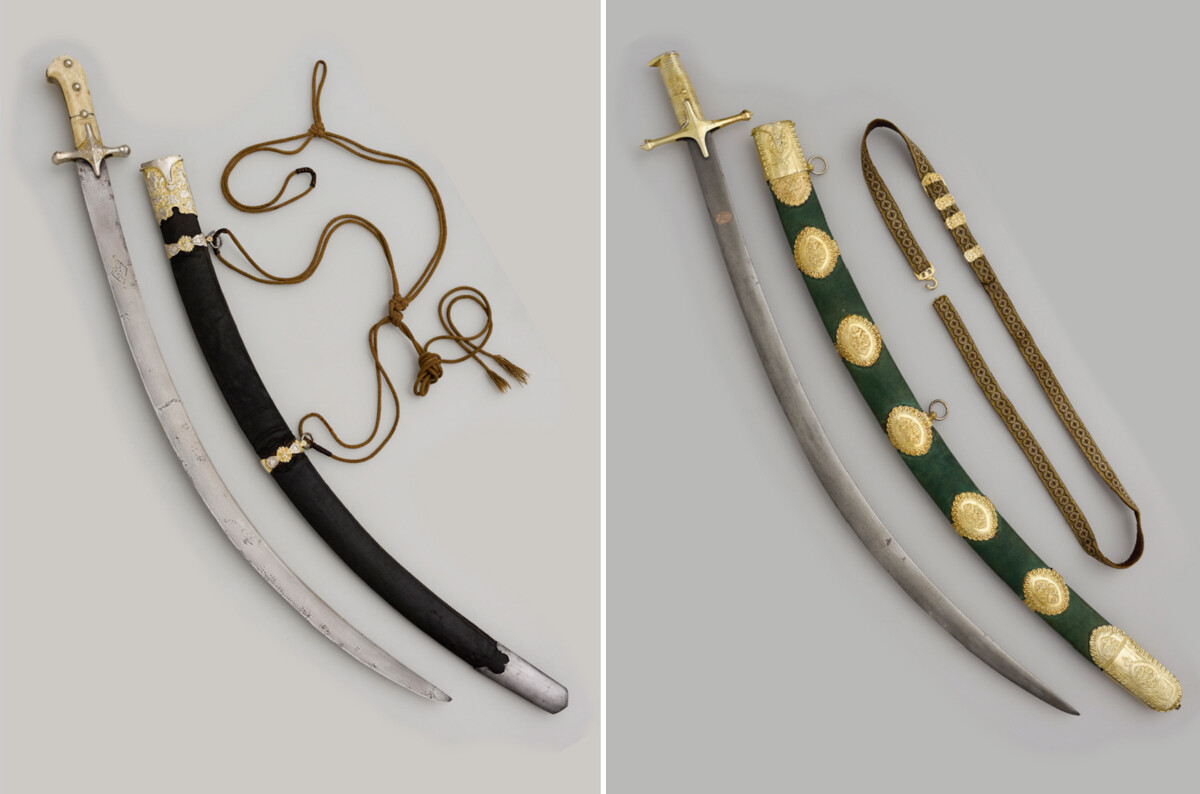
Emperor Nicholas I was a great fan of chivalry and the Middle Ages. On his order in 1830, two sabers were transferred from the Trinity-Sergius Lavra to the Armory Chamber of the Moscow Kremlin. Legend has it that they belonged to Kuzma Minin and Prince Dmitry Pozharsky, who saved Russia from the Polish-Lithuanian intervention. Minin and Pozharsky made a contribution to the monastery, which included these sabers.
Most likely, the legend was invented by one of the monastery monks, allegedly retelling an ancient oral legend. Modern Kremlin experts are sure that it is only "the fruit of a romantic interpretation of folk legends in the search for important artifacts of national history". However, this legend is still often found in popular science publications and movies.
Both blades have stamps in Arabic with the names of masters; they were made in the 17th century in Egypt (the left one) and Iran (the right one).
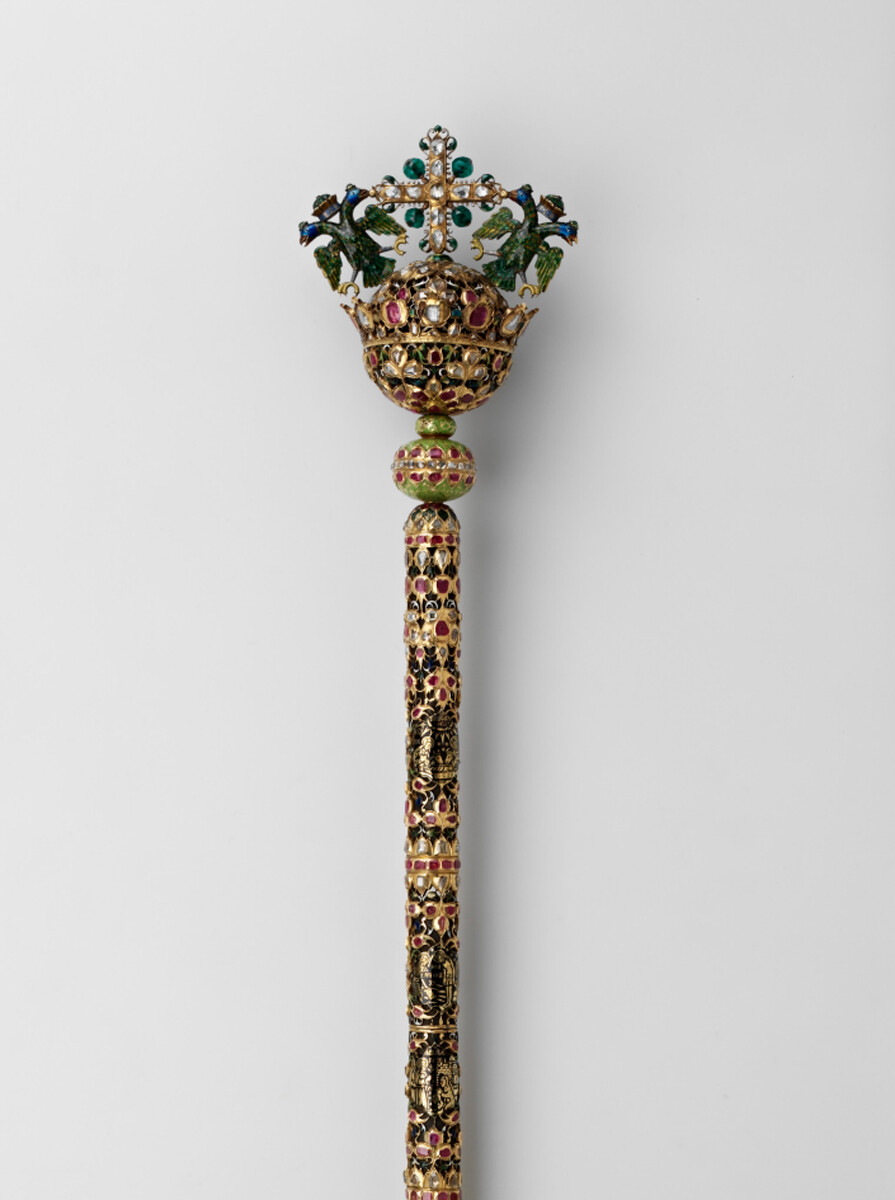
This scepter has the year 1638 engraved on it. But, despite that, in 1807, Alexei Malinovsky persistently argued that it was part of the legendary gifts of Monomakh, sent from Byzantium in the 11th century. Back in the 18th century, historian Vasily Tatishchev wrote about the “scepter of ancient Greek work” and even Catherine the Great in her notes on Russian history mentions it among Monomakh’s regalia, which are kept in the Armory Chamber.
Later, in 1835, historians suggested that the scepter was brought to Moscow by Byzantine princess Sophia Paleologos before her wedding to Russian Grand Duke Ivan III, which took place in 1472.
Taking into account the date 1638 and the artistic features of the scepter, modern experts still believe that the artifact was really made in the 17th century. It could have been made by Constantinople masters in the style of the former Greek regalia. And then, it was presented to the Russian Tsar Alexei Mikhailovich.
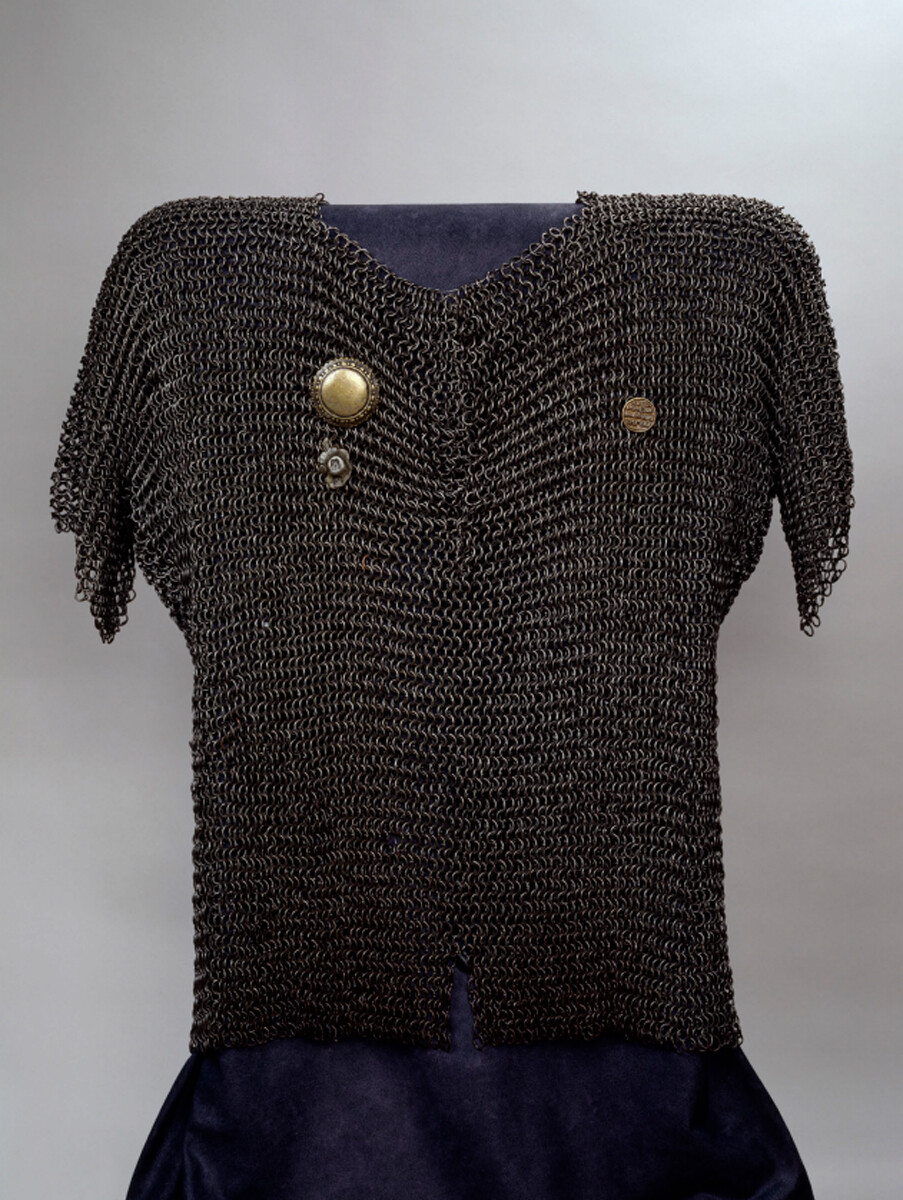
Legends about various artifacts appeared in the Soviet era, as well.
This 16th century chain mail has a copper plate with the name of the owner – Prince Peter Shuisky. It is known that he died during the Livonian War in 1564. Its previous ownership didn’t cause doubts until 1925.
Then, Soviet historian Sergei Bakhrushin suggested that this was the same chain mail that came to the armory from the Siberian city of Tobolsk. It was found during archaeological excavations at the site of the former capital of the Siberian Khanate.
Bakhrushin suggested that, after the death of Shuisky, his chain mail was transferred to the royal treasury and then Ivan the Terrible granted it to Yermak, the conqueror of Siberia. And, according to legend, it was allegedly under its weight that Yermak drowned while fleeing from the army of the Siberian Khan, who then took the chain as a trophy.
Later still, historians refuted the rather poignant legend, as there are no sources proving that Ivan the Terrible granted any armor to Yermak. In addition, Peter Shuisky was a voivode in Kazan and could have traveled to Siberia on business wearing this chain.
The exhibition ‘The Kremlin legends: Russian romanticism and the Armory Chamber’ is on display at the Moscow Kremlin Museums until January 14, 2024.
Dear readers,
Our website and social media accounts are under threat of being restricted or banned, due to the current circumstances. So, to keep up with our latest content, simply do the following:
If using any of Russia Beyond's content, partly or in full, always provide an active hyperlink to the original material.
Subscribe
to our newsletter!
Get the week's best stories straight to your inbox